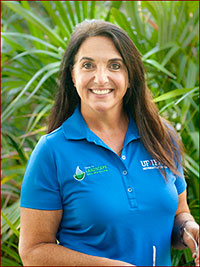Wendy's Wanderings
June 9, 2019
Summer is for Scouting
As I have been traveling around the state from the panhandle to subtropical South Florida, I have been hearing from gardeners that "we didn't have much of a winter." It is true we Florida gardeners didn't experience a cold winter and that means our plants in the landscape and the vegetable garden are well ahead of the game. But you know who else didn't have much of a winter? The six-legged pests that like to feed in our yards and gardens.
That's right, the insect populations didn't get knocked back by freezes or cold weather. Of course, in our Florida-Friendly landscapes we manage yard pests responsibly, choosing tolerance and or the least-toxic control method possible so we can preserve our beneficial insect populations and reduce chemicals in our environment. But since we can anticipate insects moving into the landscapes and garden this summer season, it is a good idea to get outside and scout for pests.
A good integrated pest management (IPM) plan includes regular scouting so you can catch pest problems when they are still small and haven't done too much damage.
To scout, simply walk through your yard or garden looking for problems. Notice signs of plant stress and damage like wilt, yellow leaves, defoliation, or distortion of leaves. Look for chewed holes on leaves or notches on the leaf edges, and webbing on the stems. Bring your magnifying glass and examine leaves for insect pests. Don't forget to look on the undersides of the leaves and flower buds. Scout at different times of the day to try to catch the culprits in the act. One evening not long ago, I discovered a beetle chewing on a bromeliad flower spike; if I hadn't been outside with my flashlight I would have never seen this.
Of course the most important part of IPM and scouting is the proper identification of the insect. You need to determine if it is a pest that should be controlled. Sometimes beneficial insects are mistaken for pests because they are hard to identify or their life stage might be confusing. The larva of lady beetles look a little scary, but at that stage, they consume many aphids. If you can't ID your insect, bring it to the UF/IFAS Extension office nearest you for a proper identification. Once you know what it is, you'll want to understand its life cycle to determine when is the best time to control the pest. Not all insects can be controlled through all of their life cycle (eastern lubber grasshopper, I am talking about you), but generally the immature life stages are more susceptible to control.
Once the pest and its life stage are identified, treatment or control is an individual decision. Not everyone can tolerate the same amount of injury in their landscape or garden. If you do choose to control the problem, first think about hand removal of the pest or of the affected area of the plant. Next, think about the least-toxic method of control. For soft bodied insects like aphids, scale, or mealybugs you can try insecticidal soaps, oils, and botanicals. Remember to always follow label instructions—the label is the law.
Remember that insects might be present and not causing serious damage to the plant. So it is a good idea to be educated on the pest as well as the plant. As for the beetle on the bromeliad, I went with the hand-removal method.
-- Wendy Wilber

